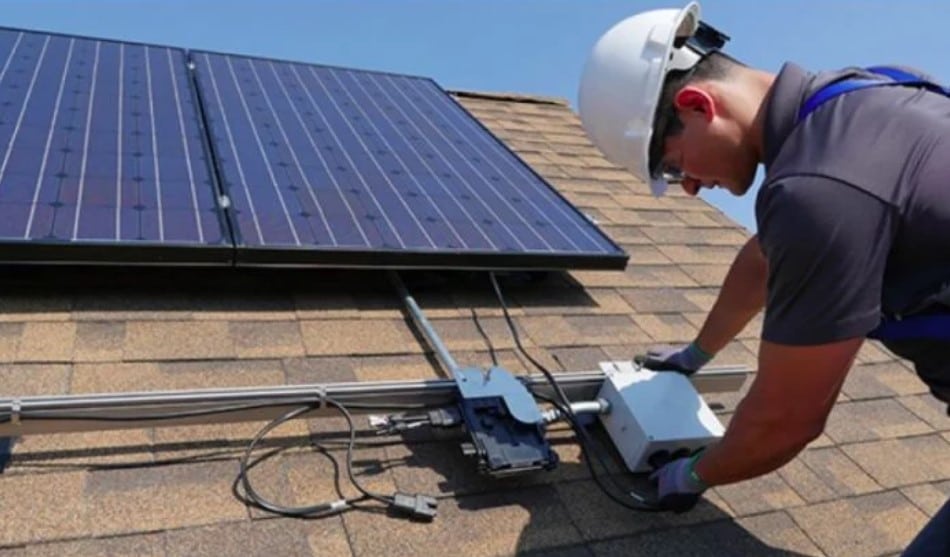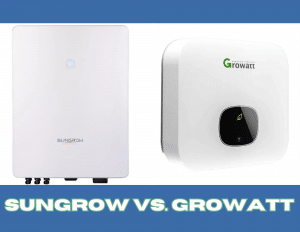A solar inverter changes direct current (DC) electricity into alternating current (AC). The inverter is an important system component because solar panels are designed to convert sunlight into DC energy. Still, your home requires AC to power all your lighting and appliances. The solar inverter converts the DC electricity produced by the solar panels into 240V AC electricity, which can then be used by the property/household, exported to the grid, or stored in a solar battery storage system.
On This Page
Are you looking to save money on your electricity bills and reduce your carbon footprint? Solar energy is the perfect solution! Energy Matters can help you get up to 3 FREE solar quotes from pre-qualified and vetted solar firms in your area.
Energy Matters has been a leader in the renewable energy industry since 2005 and has helped over 40,000 Australian households in their journey to energy independence. With Energy Matters, you can be sure you’re getting the best possible deal on solar energy. We only work with reputable solar firms with a proven track record of delivering high-quality solar systems.
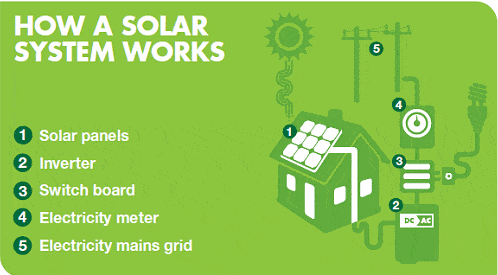
- The sun shines on the solar power panel, generating Direct Current (DC) electricity.
- The DC electricity is fed into a solar inverter that converts it to 240V 50Hz AC electricity.
- The 240V AC electricity is used to power appliances in your home.
- Surplus electricity is fed back into the main grid.
Home battery and hybrid systems are also becoming more popular, but batteries are still developing, and most solar installations still need a dedicated solar inverter.
The major benefit of a more extensive solar PV system is that it will be simple to add a solar battery, utilise your solar inverter’s capability to its fullest extent, and generate more power during the day so that you won’t be as dependent on grid electricity. You can start making the most of your solar PV system by installing a solar battery, like the GoodWe, Enphase, sonnen, Fronius, Fimer and Sungrow. Click the logos below to read more and request a quote installing their latest batteries:
Many solar inverter products also have a Wi-Fi monitor, which gives you real-time data about the solar power generated. It’s even better when you have a powerful solar panel that can measure the energy used to produce electricity.
What is an inverter used for?
Every solar power system must have solar inverters. They carry out two essential tasks:
Conversion from DC to AC
All solar panels generate Direct Current (DC), which must be converted into alternating current (AC), the type of electricity your home can use by a solar inverter.
Maximum Power Point Tracking (MPPT)
The amount of sunlight and solar panel temperature that affect how well solar panels work change throughout the day. It implies that the voltage and current that a solar panel may produce could also change constantly. The solar inverter dynamically chooses the mix of the two that will provide the maximum electricity using a process known as Maximum Power Point (MPP) tracking.
Criteria used to select the best solar inverters
Choosing a solar inverter can be accomplished by examining the following criteria.
- Efficiency, quality & reliability
- Service & support
- Monitoring
- Warranty
- Features
- Cost
- Size option
Solar Inverter Technologies
String Inverters
The most common type of solar inverter used in residential solar panel systems is the string inverter because each installation typically calls for one. Several solar panel strings connect to a single inverter. Then, for domestic usage, it transforms DC into AC.
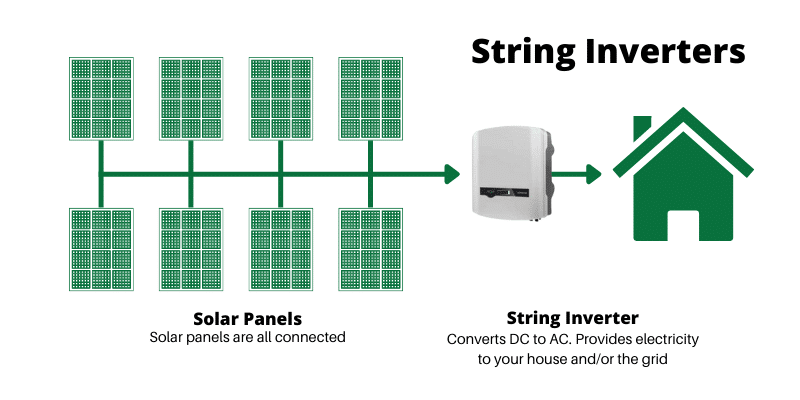
Micro Inverters
Each solar panel needs a small inverter called a microinverter to maximise its power at the module level. Even with partial shading, each solar panel still generates more electricity. Each panel’s voltage output is optimised using a microinverter to maximise output. Since each micro-inverter is connected to another, the system keeps converting DC to AC even if one microinverters fails.
Central inverters
Although they are larger and can sustain more than one string instead of just one, they are closely similar to string inverters.
Contrary to string inverters, the strings inside are united into a bix, with the DC power moving towards the central inverter box, where it is converted to AC electricity. These primarily serve business rather than domestic purposes. These are typical of commercial facilities and utility-scale solar farms.
Battery based inverter
A battery bank is necessary for battery inverters to operate. It transforms the battery bank’s DC electricity into AC energy. They can deliver power even during a power outage like hybrid inverters. Battery inverters have the drawback of interfering with the phone, radio, and television reception due to their buzzing noise. Installing sine waves will help you reduce interference.
Power optimiser
Power optimisers can be installed in systems with strings of panels and a string inverter even though they are not inverters. Like microinverters, they ensure that the output of the remaining solar panels in the string won’t be impacted if one of the panels is shaded, dirty, or fails in some other manner.
Solar PV systems and required inverters
Grid-tied inverters are intended for grid-tied solar systems, the most common system type. When necessary, they import utility electricity from the grid and maintain a two-way interaction with it, exporting solar energy to it.
Hybrid inverters function with hybrid solar systems, also known as multi-mode inverters, battery-ready inverters or solar-plus-storage systems. They can charge and draw electricity from a battery arrangement and have the same functionality as a grid-tie inverter.
Off grid inverters are utilised in off-grid solar systems, also known as entirely independent solar power systems, to provide backup power during grid outages.
An off-grid inverter cannot be linked to the grid and must have a battery backup to operate.
5 Best solar inverters in Australia
- Fronius Primo GEN24 5.0: Uncompromising efficiency meets smart home integration
- SMA Sunny Boy SB5.0-1AV-41: German engineering meets Australian sun, built to last
- SolarEdge SE5000H HD Wave: The all-in-one solar optimiser for maximum control
- Enphase IQ8 Micro-inverter: Individual panel mastery for shaded roofs and uneven systems
- Sungrow Premium SG5.0RS: Powerhouse performance with unrivalled value
What are the best solar inverters in Australia?
| Model | Warranty* | Key Features | Estimated Price Range AU$ | |
|---|---|---|---|---|
| 1. Fronius | Primo GEN24 5.0 | 10-year warranty (5 full + 5 parts only on registration) | This hybrid inverter can integrate solar batteries and backup power. It has a high efficiency of 97.6%. It also uses integrated data communication and SnapINverter technology for easy installation and servicing. | $1,300 – $3,000 |
| 2. SMA | Sunny Boy SB5.0-1AV-41 | 10-year warranty (5 full + 5 full on registration) | A single-phase inverter that uses the ShadeFix function to optimise the performance of shaded solar panels. It has a high efficiency of 97%, a user-friendly interface, and a secure power supply option. | $1,500 – $2,500 |
| 3. SolarEdge | SE5000H HD Wave | 12-year warranty (25 years for optimisers) | A single-phase inverter that works with power optimisers to maximise the output of each solar panel. It has a very high efficiency of 99.2%; has a compact and lightweight design and advanced safety features. | $2,000 – 3,000 |
| 4. Enphase | IQ8 Micro-inverter | 10-year warranty (5 full + 5 full on registration) | A micro-inverter installed on each solar panel can operate independently. It has a high efficiency of 97.4%, a plug-and-play installation, remote monitoring and troubleshooting, and enhanced safety features. | $750 to $950 |
| 5. Sungrow | Premium SG5.0RS | 10-year warranty | A single-phase inverter with a low start-up voltage 40V and a built-in DC isolator. It has a high efficiency of 97.9% and supports multiple communication methods and smart energy management. | $1,000 – $2,000 |
| 6. Huawei | SUN2000-5KTL-L1 | 10-year warranty (extendable to 20 years) | A hybrid inverter that can connect with solar batteries and backup power. It has a high efficiency of 98.4%, three MPPTs, a built-in DC switch and smart IV curve diagnosis. | $1200 to $1850$1,500 – $2,500 |
| 7. GoodWe | DNS Series | 10-year warranty (5 full + 5 parts only) | A single-phase inverter with three MPPTs and 200% DC oversizing capability. It has a high efficiency of 97.7%, a fanless cooling design, a built-in export control and a smart energy management system. | $1,000 – $2,000 |
| 8. Growatt | MIN5000TL-X | 5 years (extendable to 10 years) | Budget-friendly choice with decent efficiency (97.6%), compact design, and integrated WiFi monitoring, suitable for small to medium systems. | $800 – $1,100 |
| * Extended warranty options available – may vary depending on the country or region. **Top performers are not necessarily the same models offered in Australia but are a sign of a reputable brand. |
||||
Fronius solar inverters in the Australian market
Günter Fronius established Fronius in Austria in 1945. 1992 the company became a top inverter maker thanks to a novel snap-in installation method. The Fronius inverter has an active cooling system, numerous MPPTs for increased efficiency, and an integrated solar DC isolator that does not require an additional isolator box. The Fronius inverter offers Wi-Fi system monitoring capabilities.
Monitoring solar energy use is possible thanks to the smart meter.
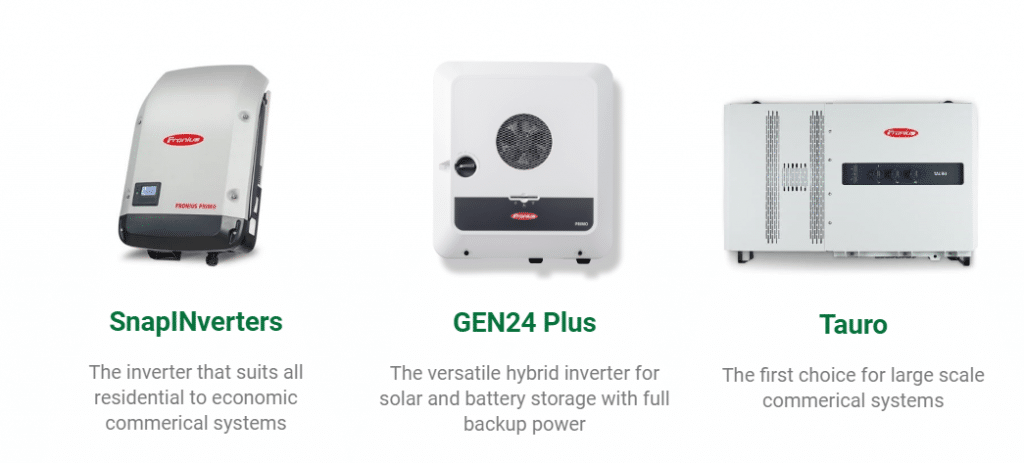
SMA solar inverter
SMA is a manufacturer of solar inverters worldwide with headquarters in Germany. It was founded in 1981. SMA has a record of producing high-quality solar equipment, including photovoltaic inverters. Both grid-connected and off-grid solar systems can use the SMA inverters.

Solar Edge inverter
Solar Edge is the third-largest inverter producer in the world. The intelligent inverter system made by Solar Edge uses DC optimisers to keep track of each panel and increase power output.
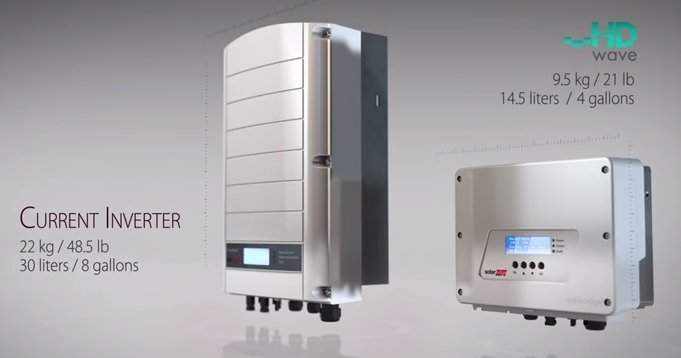
Enphase solar inverters
The most well-known brand for creating solar micro inverters is Enphase. The business began operations in the United States in 2006 and was the first to commercialise the microinverter widely and continues to be the industry leader in output. Instead of the full array of solar panels, microinverters convert, regulate, and monitor solar energy per panel.
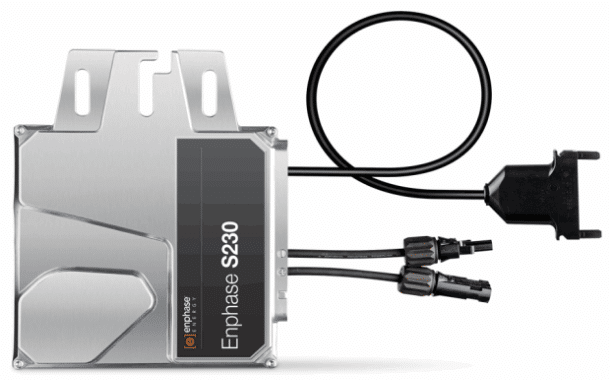
Sungrow inverters
Sungrow inverters are among the most affordable solar inverters available at the moment. Customers can select sizes ranging from 2-kW to 8-kW, affecting the solar inverter’s overall cost. Although Sungrow has alternative warranties that can extend the coverage for an additional fee, the Sungrow SG Premium comes with a 5-year warranty as standard.
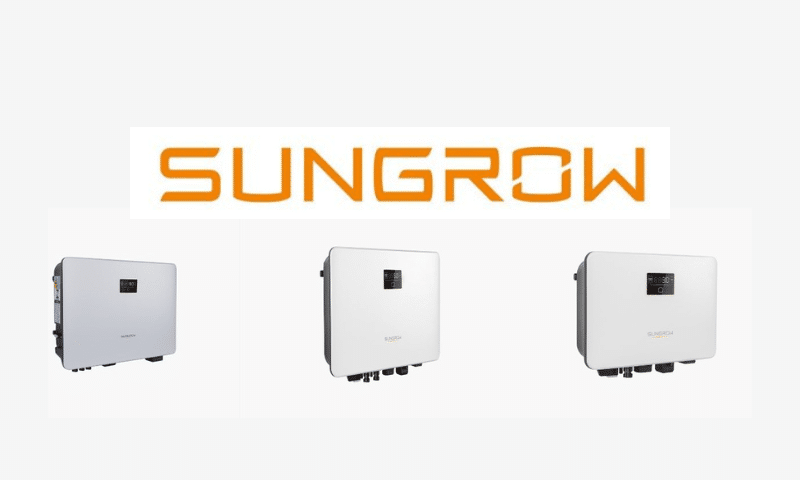
Huawei solar inverter
In addition to being well-known in the smartphone sector, Huawei is also well-known in the solar sector. It is one of the biggest inverter manufacturers and has invested heavily in solar technology research and development.
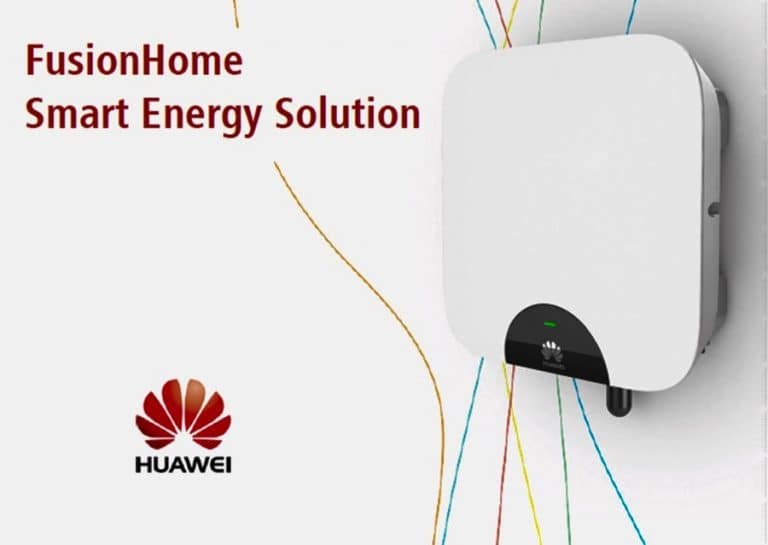
GoodWe inverter
GoodWe Power Supply Technology Co. is another name for GoodWe. Ltd. in Australia. GoodWE inverter is the top producer of string and hybrid inverters and is a common form of an inverter. Single- and three-phase inverters from 0.7 kW to 250 kW in capacity are produced by GoodWE.
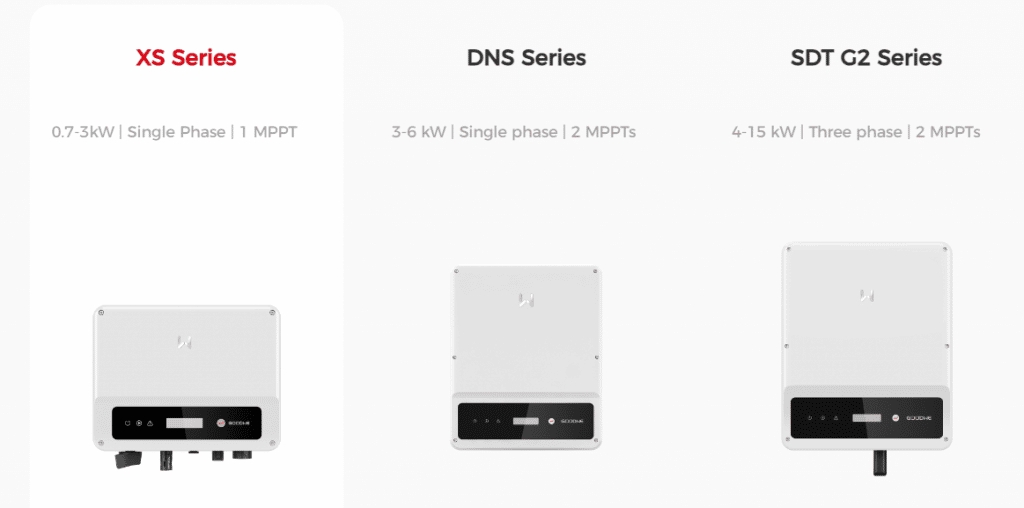
Growatt solar inverter
FIMER is a reputable inverter company with an Italian foundation that took over ABB’s solar unit in early 2020. The business is now updating many ABB-style inverters, which is also growing its selection of premium string solar inverters for utility-scale, residential, and commercial applications

Seeking the perfect match
With the information above, you’re well-equipped to navigate the world of solar inverters. But remember, your journey doesn’t stop here. Consulting a qualified solar installer is crucial for getting the best solar inverter in Australia for your specific needs and setup. They can assess your property, analyse your energy usage, and recommend the ideal inverter-panel combination to maximise your solar savings and contribute to a brighter, cleaner future for yourself and the planet.
Remember, the “best” solar inverter is subjective and depends on your specific needs and priorities. Consider factors like budget, roof layout, shading concerns, and future battery storage plans before making your choice.
Understanding your solar inverter brands
Learn all there is to know about your inverter once it has been installed. Learn the meanings of the indicator lights and displays often present on them.
It’s a good idea to regularly check in on your solar system, whether you use powerful software monitoring or just a visual inspection of the inverter’s indication panel. Early detection of issues will enable you to address them and change your electricity use to maximise the use of your solar power. You don’t want to learn the hard way from an electricity bill that your system hasn’t been working properly, and you’ve been using grid power rather than solar power!
Contact us for professional guidance on solar inverters and a price estimate for a home or business’ high-quality solar panel installation.
Energy Matters has been a leader in the renewable energy industry since 2005. We can connect you with our trusted local solar installers, who will provide up to 3 FREE solar quotes for your home and business solar energy system.
Updated on January 2024











